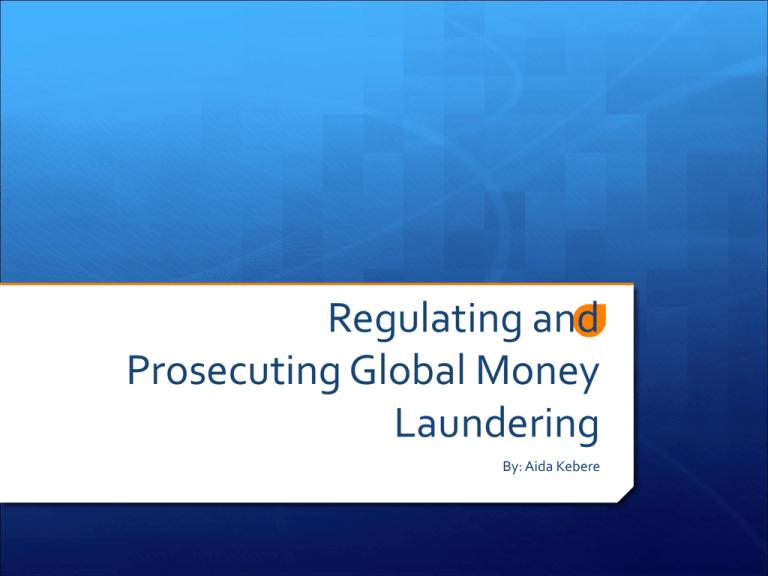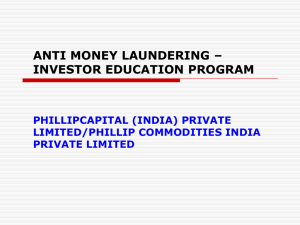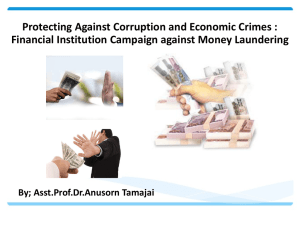PPt. - International Trade Relations
advertisement

Regulating and Prosecuting Global Money Laundering By: Aida Kebere What is Money Laundering? Money Laundering is the process of making illegally-gained proceeds( i.e. “ dirty money “) appear legal (i.e. “clean). How does money laundering work? 1. Placement: refers to the initial point of entry for the funds derived form the criminal activities. 2. Layering : refers to the creation of complex networks of transactions which attempt to obscure the link between the initial entry point and the end of the laundering cycle. 3. Integration: refers to the return of funds to the legitimate economy for later extraction Crimes Associated With Money Laundering 1. Drug trafficking 7. Foreign official corruption 2. Terrorist financing 8. Exchange control violation 3. Financial fraud 9. Illegal gambling 4. Computer Crimes 10. Bribery of public officials 5. Alien smuggling 11. Misappropriation, theft 6. Illegal arms sales 12 Embezzlement of public fund Who may be Potentially Exposed? Banks Financial institutions International Business Operations Companies Investors Corporate executives Individuals The Financial Action Task Force (FATF) FATF is an inter-governmental body established in 1989 by the Minister of its Member jurisdictions. Sets international standards , promote effective implementation of legal, regulatory and operational measures. FATF currently has 34 members jurisdictions and 2 regional organizations. U.S. AML Laws and Regulations Bank Secrecy Act of 1970 (BSA) The Uniting and strengthening America by Providing Tools required to intercept and Obstruct Terrorism Act of 2001 ( commonly referred to as USA Patriot Act). Money Laundering Control Act of 1986 (MLCA) Anti-Drug Abuse Act of 1988 Act of 1992 Money Laundering Suppression Act of 1994 (MLSA) Money Laundering and Financial Crimes Strategy Act of 1998 Anti Money Laundering Statutes 1. Comprehensive oversight, monitoring, and reporting framework designed to limit money laundering activity, focused primarily on financial institutions. 2. The criminalization of money laundering activities by any individual or corporation The Statute of the Money Laundering Act The statute allows for a broad jurisdictional hook The Statute can reach any U.S. citizen anywhere in world, if part of the conduct takes place in the U.S. Transactions value exceeds $10,000 Key U.S. Regulatory Authorities 1. Financial Crimes Enforcement Network (FinCEN) 2. Self-Regulatory Organizations (SROs) 3. Financial Industry Regulatory Authority (FINRA) 4. Department of Justice (DOJ) Anti-money laundering (“AML”) programs - Information sharing, Risk Assessments -Customer Acceptance and Maintenance Program -Large Currency Monitoring and Currency Transaction Report Filling Program - Monitoring, investigating and Suspicious Activity Filling Program - Sanction Program , Information Sharing, Training ,Record keeping and Retention Programs HSBC’s Case HSBC’s U.S branch failed to monitor transactions with branches in other countries for money- laundering violations. It accepted $15 billion without further inquiry HSBC was fined by both the U.S. and British regulators. HSBC to pay $1.9 BILLION U.S. fines HSBC has also shouldered significant remediation costs Policy Proposal Strengthen and refine the Anti-Money Laundering regulatory regimes for all financial institutions Improve the effectiveness of the AML controls through greater guidance, communication and information sharing Re-evaluate some of the existing procedures Improving compliances systems Impact of proposal Pros Cons - Will comply with regulation - Mitigate risks - Won’t have to pay fines - you can’t deal with certain - Build strong brand in the industry parameters - - Costly to continuously revamp the procedures - have to alienate certain industries due to sanctions











